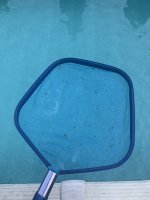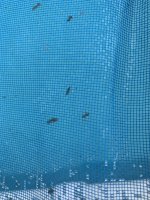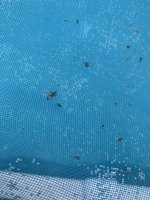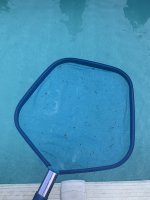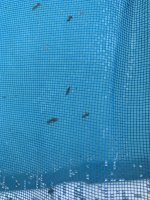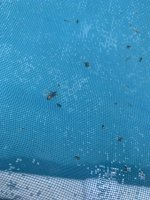It sounds like you have a nascent algae bloom and need to complete the
SLAM Process. In order to properly slam the pool you will need an FAS/DPD test kit such as a tf100 or a Taylor k2006. The test strips you are using are inaccurate. If you really had a total chlorine of 5ppm and a free chlorine of 1ppm, that means you have combined chlorine of 4ppm. Combined chlorine + free chlorine = total chlorine. Combined chlorine is the waste product of chlorine sanitation, it generally has a harsh chlorine smell and it is not something you want in your pool. While I don't really trust pool store testing either, it probably would have showed up on their test if you had CC of 4ppm.
Currently your chlorine is too low for your CYA level. When you have a CYA of 90ppm and do not use a saltwater chlorine generator, your FC needs to be 10-12 ppm in order to kill any organic debris and sanitize the water. Bringing chlorine to slam levels will kill the bugs and any algae you may have. Also since your CYA is so high it would be best to drain about 60% of the water to get the CYA to a reasonable level, then complete the slam process.
Here is some additional information for you to read.
ABCs of Pool Water Chemistry
FC/CYA Levels
And something I use to explain why TFP's recommendations will look different from pool store recommendations.
The problem with conventional recommendations is that they treat each chemical value as a separate entity that has no relationship to any other chemical value. For example, conventional recommendations only look at chemical values in their individual ranges, such as FC (chlorine) must be between 1-3ppm, without taking into account how other chemical values interact with each other. This is why they will say a CYA of 90 and FC of 2 are "perfect", because they both fall within the acceptable range for each value. However, CYA and Chlorine must be maintained in a proper ratio to each other. If you look at the FC/CYA Chart you will see that if CYA is 90 in a manually chlorinated pool, FC of 2 is far too low and algae will form under those conditions.
TA and pH are another example. Conventional standards want a TA of 90-120 and pH of 7.5 TA is generally only a concern when pH is difficult to balance. If you have a TA of 70 and a pH of 7.5 there is no need to adjust the TA just to meet an arbitrary value. If you do raise the TA to 90, then your pH is also going to rise. If you lower the pH the TA will also drop. pH can be 7.0 to 7.8 in most pools without causing further issues. There is no need to chase a perfect TA and a perfect pH if your pH is in the acceptable range and fairly stable. TA by itself means nothing.
pH and calcium also have a relationship to watch. Conventional recommendation for calcium is 250-450ppm and in most pools this is not a problem. However if you live in an area with very hard water it may be next to impossible to keep the calcium below 450. In that case it is important to keep your pH low, around 7.0, to prevent calcium scale formation in the pool.
Strictly following conventional recommendations can lead you to a pool full of problems if you don't know how the relationships between chemicals work. Knowing these relationships also guides what types of products to use in the pool. If CYA is high enough you don't want to use dichlor granules or trichlor tablets in your pool to provide chlorine. Both of these products contain CYA and will cause CYA to rise over time. The only way to get rid of excess CYA is to drain water out of the pool. It does not evaporate out with the water. Calcium hypochlorite adds calcium to the water along with chlorine. Like CYA, the only way to get rid of excess calcium is to drain water. Liquid chlorine is the only chlorine source that does not add either CYA or calcium to a manually chlorinated pool.
TFP has the real life experiences of thousands of pool owners, plus the opinions of professionals who have read peer reviewed research that supports our pool care method. Our methods work for the majority of private pool owners.


